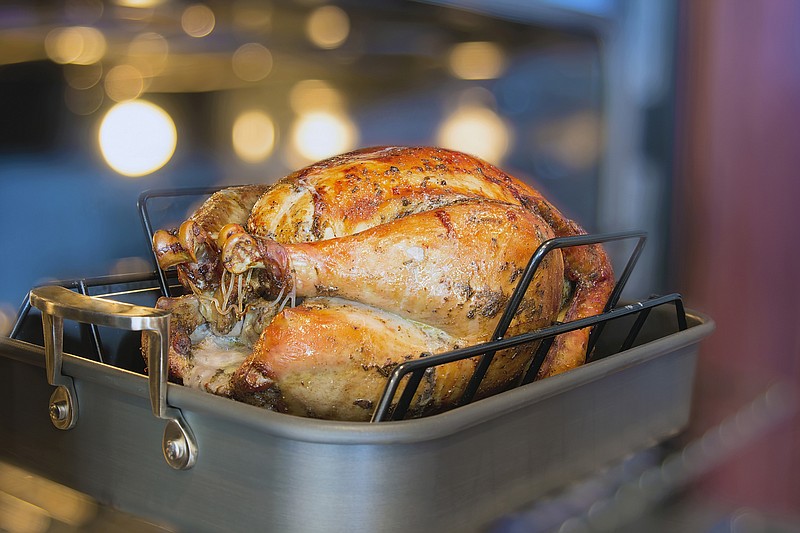We've all had overcooked, dry turkey on Thanksgiving. And it doesn't have to be. To make sure that doesn't happen, it's best to brine the turkey.
Brining has become one of the standard methods for cooking turkey. It's a simple way of adding flavor, ensuring moist meat and that your turkey isn't overcooked.
It's been our foolproof method for many, many years. It's best to brine the turkey at least overnight. There are two methods of brining: a wet brine and a dry brine.
Why brine? It helps add seasoned moisture to the turkey. During brining the seasoned liquid for the wet brine (usually salt and water) gets trapped inside the meat cells and is released when cooked.
With dry-brining, the turkey is rubbed with salt, which is sometimes mixed with other dry seasonings. The salt draws moisture to the surface, mixes with the salt and is reabsorbed.
Do not wet or dry brine kosher turkeys or self-basting turkeys. Here are basic ingredients and instructions for both methods based on using a 12- to 15-pound fresh turkey:
Wet brine
Ingredients: 2 cups of kosher salt, 2 gallons of water.
Equipment: A tall 5-gallon bucket.
How-to: Place 4 cups of the water in a saucepan, and add the kosher salt. Heat over medium heat until the salt is dissolved. Remove from heat, and add ice cubes to cool the mixture. Place the mixture with the remaining water in a large bucket. Submerge the turkey, breast side down, in the water.
Place in the bucket in the refrigerator at least 12 hours or overnight.
Prior to cooking, remove the turkey from the bucket, and discard the brine. Rinse the turkey well under cold water, and pat dry. Place the turkey back on a sided baking sheet and let sit one hour before roasting.
Dry brine
Ingredients: 4 tablespoons kosher salt.
Equipment: One oven bag or sealable bag large enough to hold the turkey. Rimmed baking sheet or other sided dish. You can also cover the turkey with plastic wrap.
How-to: At least one day before roasting, rinse the turkey inside and out and pat dry. Sprinkle 1 tablespoon of kosher salt in the cavity of the turkey. Rub the remaining salt all over the entire bird. Place the turkey in the bag, and seal it. Refrigerate for at least 12 hours and up to 24 hours.
Prior to cooking, remove the turkey from the bag, and pat dry with paper towels. There should be no visible salt on the skin - lightly brush it off if there is. Let stand at room temperature one hour before roasting.
Serves: 10-12
Preparation time: 30 minutes (plus overnight brining)
Total time: 3 hours
Brine
4 cups orange juice
3 quarts water
2 cups kosher salt
1 cup sugar
Herb sprigs (rosemary, thyme, parsley), optional
Turkey
1 fresh or frozen turkey (12 to 15 pounds), thawed
4 to 6 cups reduced sodium chicken broth
2 tablespoons vegetable oil or melted butter
Salt and pepper to taste
To brine the turkey, start with a large, clean bucket. Make room for the bucket in your refrigerator - adjusting shelves if necessary.
Remove the neck and giblets from the turkey, and reserve them for another use.
In the large bucket, stir together the orange juice, water, salt and sugar. Continue stirring until the salt and sugar dissolve. Add herb sprigs, if using. Place the turkey in the brine, breast side down. Add more water if the turkey isn't completely submerged in the liquid. Place the bucket in the refrigerator for at least 10 to 12 hours or overnight.
Two hours before you plan to roast it, remove the turkey from brine and discard the brine. Rinse the turkey well, inside and out, under cold water for several minutes. Place the turkey on a tray and pat it dry well with paper towels. Let it sit out for 1 hour so the skin dries further, which helps crisp the skin.
Preheat the oven to 400 degrees. Place a V-rack in a roasting pan.
Add about 2 cups of the chicken broth to the pan. Place the turkey breast side up on the rack. Brush the turkey with the vegetable oil or rub with softened butter. Season the turkey with salt and pepper or favorite seasoning.
Place it in the oven and roast for 30 minutes. Baste the turkey with the pan juices, and add more chicken broth to the pan if needed. Reduce the oven temperature to 350 degrees. Continue roasting another 2 to 2 1/2 hours, basting with the pan juices every 30 minutes or until the internal temperature reaches 165 degrees.
If the breast seems to be browning too quickly, cover it with foil.
Remove the turkey from the oven and transfer it to a platter. Cover it with foil and let it rest at least 15 to 30 minutes before carving.
From and tested by Susan M. Selasky for the Free Press Test Kitchen.
Analysis based on 5 ounces white meat without skin.
307 calories (45 percent from fat), 15 g fat (5 g saturated fat), 0 g carbohydrates, 40 g protein, 391 mg sodium, 121 mg cholesterol, 0 g fiber.

